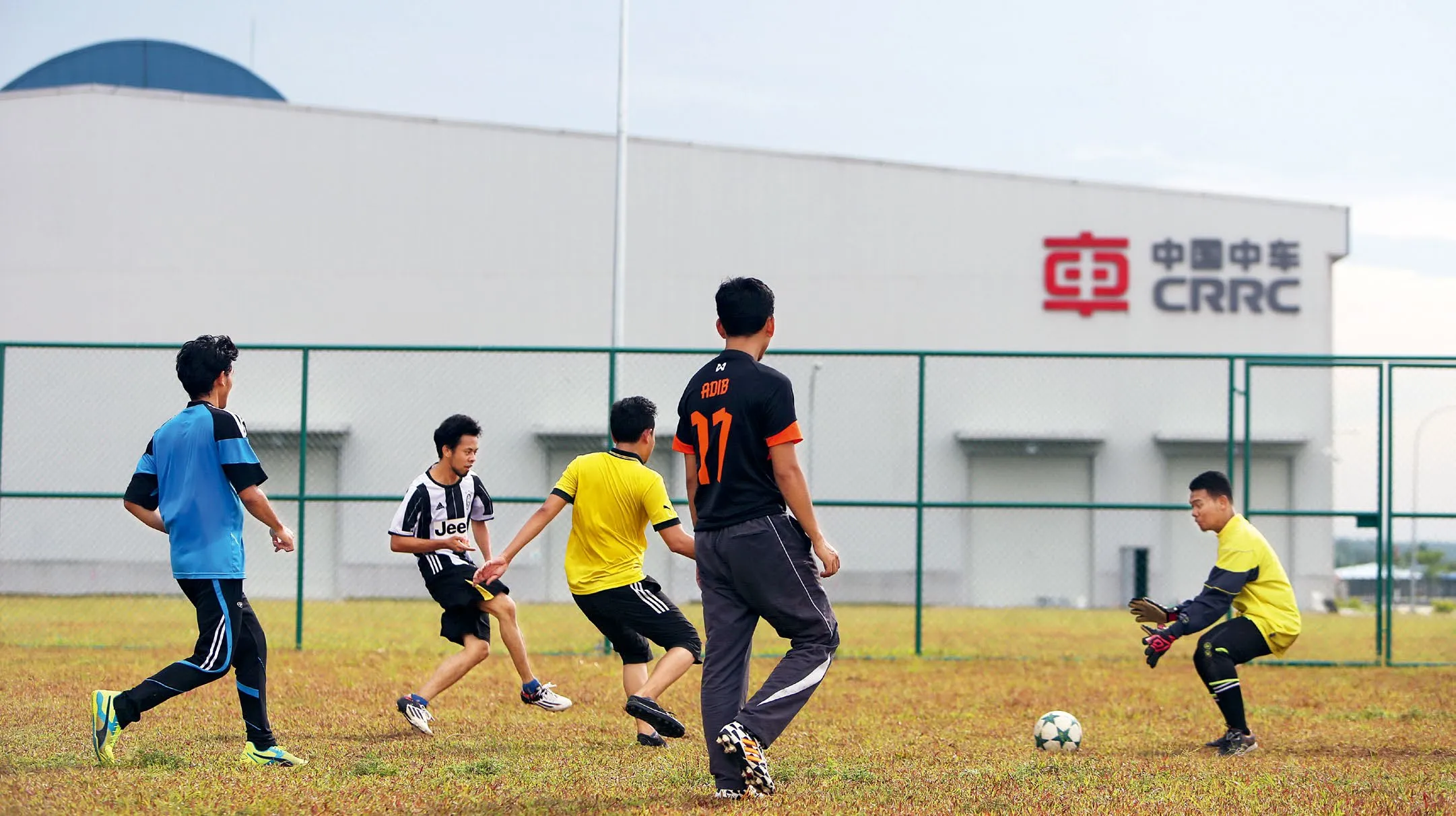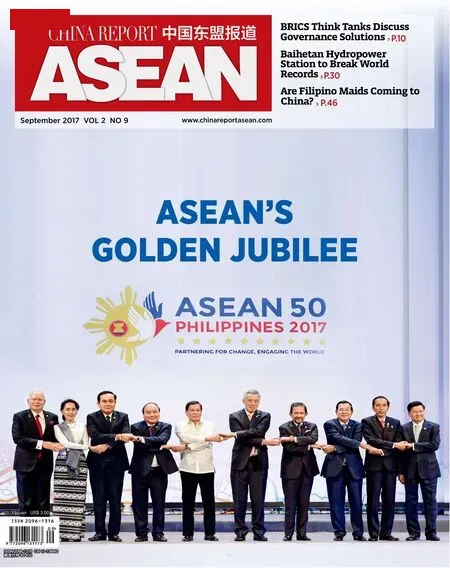ASEAN, 50 YEARS ON
By Wang Yuzhu
ASEAN, 50 YEARS ON
By Wang Yuzhu
ASEAN Community’s success in maintaining stability has brought growth and opportunity to countries across the region

A weekly football match at the CRRC (Malaysia) Railway Vehicles Company manufacturing center. The CRRC project has allowed Malaysia to become the first country in ASEAN capable of developing railway products.
Fifty years since the start of something important is a suitable moment to take time for celebration and reflection, especially for ASEAN.
In 1967, after failed attempts at cooperation, Southeast Asian countries began to explore a new cooperation arrangement — the Association of Southeast Asian Nations, otherwise known as ASEAN. Although the move did not attract much attention at the outset, Southeast Asian countries started building ASEAN with the exploration of a cooperative paradigm suitable for the region. Over the last 50 years, in the context of differences in politics, economics, religion, history and many other fields, Southeast Asian countries have pioneered a paradigm of regional cooperation and community building on the basis of pluralism.
As an important regional organization and economic partner, ASEAN’s relations with China have developed amidst twists and turns over the last 50 years.
Regional Perspective
From a relatively macro and comprehensive point of view, the most remarkable achievement of ASEAN over the past 50 years was its involvement in reshaping the geopolitical and economic landscape of the Asia-Pacific region, particularly East Asia. After World War II, especially after the Cold War, the political situation in Asia-Pacific has gradually evolved from confrontation to cooperation. It’s common wisdom that the rapid rise in comprehensive strength with China as the forerunner has given rise to changes in the geopolitical and economic situation in the Asia-Pacific region, especially East Asia. However, this belief has obviously overlooked the “hub-and-spoke”structure that ASEAN has built in East Asia with the balance of power, and its impact on the region’s geopolitics and geoeconomics. Some may argue that ASEAN’s centrality is endowed by the special power pattern in Asia-Pacific, but that does not change the functional power that ASEAN has thus gained, nor does it erase the role of ASEAN inreshaping the region’s political and economic structure.
ASEAN reshaped the concept of Southeast Asia and made Southeast Asian countries an important force in the power structure of East Asia in the name of a regional bloc. ASEAN member states were part of the Far East during World War II. Even when ASEAN was first established, it was still vague which Southeast Asian countries should be adopted as ASEAN member states. ASEAN gradually defined the geographical concept of Southeast Asia during the 32 years of enlargement. In 1999, Cambodia was officially accepted as the last member state. The ASEAN framework of 10 Southeast Asian states was thus identified.
As a regional bloc that “speaks with one voice” in international affairs, ASEAN has gained a stronger political presence for Southeast Asian states than other Asian states. ASEAN promoted the signing of theTreaty of Amity and cooperation in Southeast Asia. It has adhered to the peaceful resolution of conflicts and promoted the denuclearization of Southeast Asia. All the efforts have further enhanced recognition of ASEAN by the international community.
ASEAN's contribution to the maintenance of internal peace has received much acclaim. In his bookConstructing a Security Community in Southeast Asia, Canadian writer Amitav Acharya systematically expounded his views on the role of ASEAN in safeguarding the security of Southeast Asia. Many readers have chosen to support his assertion that ASEAN's greatest contribution has been the maintenance of regional security. From a historical perspective, ASEAN's development is indeed a process for Southeast Asia to evolve from a battlefield to a marketplace. Therefore, it is reasonable to stress ASEAN's contribution to security. But to be more fair, it was the overall international situation gradually evolving from confrontation to cooperation after the end of World War II that laid the foundation for ASEAN to play its role in maintaining security.
On the basis of internal unity and stability, Southeast Asian countries have constructed cooperative relationships with other big countries in the region, and joined the “hub-and-spoke”structure of the balance of power. In contrast with the “hub-andspoke” system that the United States has set up through treaties with its allies for security, ASEAN’s relations with major powers have been sustained more with economic cooperation. So far, ASEAN has signed five bilateral free trade agreements with China, Japan, South Korea, Australia, New Zealand and India. On that basis, ASEAN is negotiating with its partners on a Regional Comprehensive Economic Partnership (RCEP). Each year, ASEAN hosts a series of meetings in its member states, which has become an important platform for summit diplomacy in the Asia-Pacific region.
ASEAN has supported its economic rise with economic cooperation, which has substantially changed the geoeconomic pattern of the Asia-Pacific region, especially East Asia. Overshadowed by China and India's dazzling growth in recent years, ASEAN’s economic growth has been overlooked. As a matter of fact, after the 1997 financial crisis, Southeast Asian countries have within the framework of ASEAN accelerated economic integration and pushed forward their cooperation with all major economies. ASEAN economies have made remarkable achievements over the last 20 years.

Left: ASEAN Regional Forum Disaster Relief Exercise 2015 participants from China, Malaysia, Thailand and India on board the China Maritime Safety No. 31 patrol vessel on the Strait of Malacca on May 27, 2015.

Right: Artists perform at a ceremony marking the 50th anniversary of the founding of ASEAN in Manila on Aug. 8.
$2,000
Per capita GDPin Vietnam, up from less than $100 in 1990
$500
Bilateral trade, in billions, between China and ASEAN countries
1999
The year in whichCambodia joined ASEAN, the most recent country to join the regional bloc
The Economic Research Institute for ASEAN and East Asia (ERIA) published an academic monograph on the economic achievements of ASEAN, which includes data illustrating the successful performance of ASEAN economies, especially new member economies on the Indochina Peninsula, including Vietnam, Laos, Cambodia and Myanmar. At present, the average per capita GDP of these countries has exceeded US$1,000. The figure for Vietnam has even soared to US$2,000 from lessthan US$100 in 1990.
With a total population of over 600 million, the rapid regional economic growth in the 10 ASEAN member states has attracted increasing attention from the international community in areas of total GDP, import and export volume, outbound investment and inbound investment. With the establishment of the ASEAN Economic Community, ASEAN will grow into a regional economy on par with China, Japan, India and other countries. When ASEAN is active in East Asia and the world economic arena as an independent economy, it will not only be of geopolitical significance, but also change the geo-economic pattern of East Asia.
ASEAN-China Relations
In terms of bilateral relations, the factors impacting ASEAN's political and economic development over the past 50 years have naturally become the basis for the development of relations between China and ASEAN.
The primary impact is on the economy. ASEAN economies have experienced growth and strong cooperation over the past 50 years, which has greatly upgraded internal integration. This integration has enhanced ASEAN’s role as an important economic and trade partner of China. Since the establishment of official cooperative relations, trade between China and ASEAN has grown from less than US$10 billion to nearly US$500 billion. Two-way investment has also increased, leading to a beneficial cyclical pattern. The fact that ASEAN has become China's third largest trading partner has changed the structure of China's international economic relations. Against the backdrop of the Belt and Road Initiative, China will naturally pay close attention to the comprehensive strategic cooperation partnership with ASEAN after 50 years of integration. A lot is expected of the cooperation between the two.
On the other hand, in terms of regional cooperation, ASEAN’s integration over the past 50 years and the rapid growth of its member economies have strengthened its role as a central platform for regional cooperation. China has consistently and firmly supported ASEAN's leading role in regional cooperation. The potential for cooperation in trade and investment brought about by ASEAN's internal integration has attracted more attention from the countries in the region. That has been a key internal cause which has consolidated ASEAN’s “core position” in East Asia.
Of course, to further improve bilateral cooperation on the basis of what has been achieved with ASEAN integration, it is important for China to make careful analysis of the achievements and shortcomings of this cooperation and lay down targeted measures for future cooperation. For example, ASEAN’s development over the past 50 years has upgraded its overall economic cooperation with China. However, the interests of different ASEAN states in regards to China are not always the same, meaning that there is no uniform program for the promotion of China-ASEAN economic cooperation, especially in the implementation of the Belt and Road Initiative. It is essential to come up with a special program for each of the ASEAN member economies.
In terms of political security, the primary task is to enhance mutual trust. After 50 years’development, especially with the building of the ASEAN Community, ASEAN has stressed“speaking with one voice”in its external relations. The formation of this one voice is in fact a coordinated process of national positions. Externally, the outcome of this process is more often than not a problem or contradiction with one or several ASEAN members being clearly articulated as a problem or contradiction with ASEAN. Through this process, ASEAN gains the negotiating power that its members cannot gain individually. It’s a smart choice. We should respect ASEAN’s way of “speaking with one voice”, while looking for ways out of the problem or contradictions in the process. Besides, in the architecture of ASEAN’s balance of power, China has been incorporated as an important dialogue partner.
Generally speaking, ASEAN has for half a century overcome tremendous challenges with diversity and achieved a lot in community building, which has had a positive impact on the geopolitics and economic situation of the Asia-Pacific region. The cooperation between China and ASEAN started from the latter half of the process and has made great progress.
To prepare for the future, we must have a clear understanding of both history and reality, so as to evaluate the development of ASEAN objectively and assess its orientation accurately. Only in that way can a more mature and stable relationship be gradually secured.
About the author:
Wang Yuzhuis a research fellow at the Chinese Academy of Social Sciences’ Institute of Asia-Pacific Studies.
The primary impact is on the economy. ASEAN economies have experienced growth and strong cooperation over the past 50 years, which has greatly upgraded internal integration.

